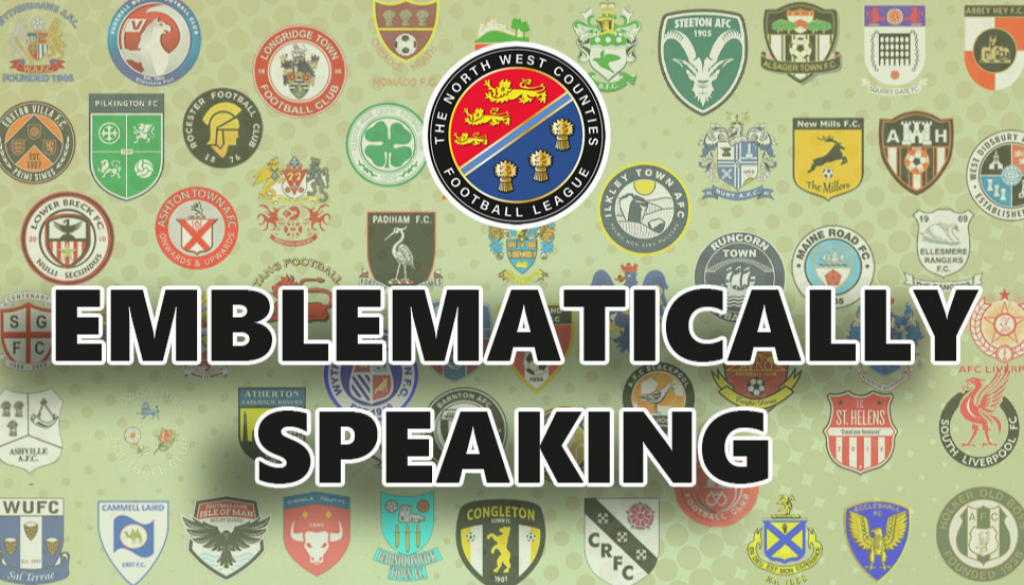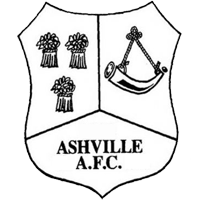
Emblematically Speaking - Ashville
Thu 6th October 2022 | Ashville | By Stewart Taylor
This week we move on to consider the emblem of one of the teams which joined the NWCFL this season.
What we are looking at here is a relatively simple emblem behind which is the story of quite a remarkable man. That man is John Dennett and I have had the privilege of meeting him and listening to some of his history as well as that of Ashville FC.
John wouldn’t perhaps mind too much if I was to reveal that he is 98 years old and a World War 2 veteran. There have been many articles written about John, particularly his distinguished service in the Royal Navy in World War 2.
It is not the role of this article to reprise this part of the story but I can certainly recommend an on-line search for John which reveals a number of articles detailing his exploits.
A native of Wiltshire, John moved “oop north” to Wallasey after the war and was married to Joyce. It is said that it was Joyce who inspired John to set up a football club which he duly did in 1949.
The world of heraldry is full of symbolism. Much of that symbolism is related to place and purpose in such a way that a glance at a well designed emblem or Coat of Arms can convey a tremendous amount about the organisation which uses such symbolism. We have to recall that it was not that long ago, in the grand scheme of things, that the majority of the population of this and many other countries were largely illiterate hence pictures were hugely significant in conveying meaning and context.
The emblem of Ashville FC has changed a little in design down the years but the elements of it were carefully chosen and have remained.
The shield itself is of a shape from the family known as Fleur-de-Lis shields and dates back at least 400 years. We readily see that the shield is split into three parts and we can consider these parts one by one.
The basal third shows simply the name of the football club.
The symbol in the left upper side is the three wheatsheaves of the County of Cheshire and we have seen the use of this symbol in the emblems of many of our Cheshire based clubs. Heraldically, these wheatsheaves are known as “garbs” and are usually depicted in a Gold colour (known as Or in classical Heraldry) – the colour of wheat as ripened in the fields of the county.
The use of the garbs to represent Cheshire goes back to Norman times (11th century) when William the Conqueror created the Earldom of Cheshire.
The symbol in the right upper side is a representation of the Wirral Horn. It is said that Mr. Dennett approached the Wirral District Football Association for permission to use the horn in the emblem of his club as the Wirral FA logo is that horn. Permission was granted but the Wirral Horn has a history of its own.
The Horn is something over 900 years old and had a significant practical use in its day. The story goes that on the granting of lands to the chief forester of Wirral by the Earl of Chester, the chief forester was obliged to blow the horn on the days of the local fair and that a toll on all the goods sold within the sound of the horn was then due to the Earl. A cunning plan indeed – predating Blackadder by some years - and it worked. The horn features to this day on the Wirral Coat of Arms.
The horn is currently held by the Earl of Cromer and resides not in the pretty Norfolk town of Cromer but in Somerset. Attempts have been made to repatriate the horn but to no avail – echoes here of the ongoing debate concerning the Elgin Marbles perhaps!
So, in three seemingly simple devices we can see that the emblem is representing a football club called Ashville FC. It is located within the County of Cheshire and, to narrow it down, on the Wirral Peninsula.
I have asked a number of Wirral residents if they are aware of a town or district within the Wallasey area or within Wirral which bears the name Ashville. They have not, which rather leads us to think how the football club got its name.
Our story goes full circle back to John Dennett. As we have seen, John moved to Wallasey when he married and the house John and Joyce lived in was in Ashville Road, Wallasey – not too far from the ground. Mystery solved and it is such a good story that it must be true.
My thanks go to John Dennett and other members of the Ashville FC committee for their help in providing information for this article.
 Emblematically Speaking - Ashville
Emblematically Speaking - Ashville
Thu 6th October 2022 | Ashville
By Stewart Taylor

This week we move on to consider the emblem of one of the teams which joined the NWCFL this season.
What we are looking at here is a relatively simple emblem behind which is the story of quite a remarkable man. That man is John Dennett and I have had the privilege of meeting him and listening to some of his history as well as that of Ashville FC.
John wouldn’t perhaps mind too much if I was to reveal that he is 98 years old and a World War 2 veteran. There have been many articles written about John, particularly his distinguished service in the Royal Navy in World War 2.
It is not the role of this article to reprise this part of the story but I can certainly recommend an on-line search for John which reveals a number of articles detailing his exploits.
A native of Wiltshire, John moved “oop north” to Wallasey after the war and was married to Joyce. It is said that it was Joyce who inspired John to set up a football club which he duly did in 1949.
The world of heraldry is full of symbolism. Much of that symbolism is related to place and purpose in such a way that a glance at a well designed emblem or Coat of Arms can convey a tremendous amount about the organisation which uses such symbolism. We have to recall that it was not that long ago, in the grand scheme of things, that the majority of the population of this and many other countries were largely illiterate hence pictures were hugely significant in conveying meaning and context.
The emblem of Ashville FC has changed a little in design down the years but the elements of it were carefully chosen and have remained.
The shield itself is of a shape from the family known as Fleur-de-Lis shields and dates back at least 400 years. We readily see that the shield is split into three parts and we can consider these parts one by one.
The basal third shows simply the name of the football club.
The symbol in the left upper side is the three wheatsheaves of the County of Cheshire and we have seen the use of this symbol in the emblems of many of our Cheshire based clubs. Heraldically, these wheatsheaves are known as “garbs” and are usually depicted in a Gold colour (known as Or in classical Heraldry) – the colour of wheat as ripened in the fields of the county.
The use of the garbs to represent Cheshire goes back to Norman times (11th century) when William the Conqueror created the Earldom of Cheshire.
The symbol in the right upper side is a representation of the Wirral Horn. It is said that Mr. Dennett approached the Wirral District Football Association for permission to use the horn in the emblem of his club as the Wirral FA logo is that horn. Permission was granted but the Wirral Horn has a history of its own.
The Horn is something over 900 years old and had a significant practical use in its day. The story goes that on the granting of lands to the chief forester of Wirral by the Earl of Chester, the chief forester was obliged to blow the horn on the days of the local fair and that a toll on all the goods sold within the sound of the horn was then due to the Earl. A cunning plan indeed – predating Blackadder by some years - and it worked. The horn features to this day on the Wirral Coat of Arms.
The horn is currently held by the Earl of Cromer and resides not in the pretty Norfolk town of Cromer but in Somerset. Attempts have been made to repatriate the horn but to no avail – echoes here of the ongoing debate concerning the Elgin Marbles perhaps!
So, in three seemingly simple devices we can see that the emblem is representing a football club called Ashville FC. It is located within the County of Cheshire and, to narrow it down, on the Wirral Peninsula.
I have asked a number of Wirral residents if they are aware of a town or district within the Wallasey area or within Wirral which bears the name Ashville. They have not, which rather leads us to think how the football club got its name.
Our story goes full circle back to John Dennett. As we have seen, John moved to Wallasey when he married and the house John and Joyce lived in was in Ashville Road, Wallasey – not too far from the ground. Mystery solved and it is such a good story that it must be true.
My thanks go to John Dennett and other members of the Ashville FC committee for their help in providing information for this article.


